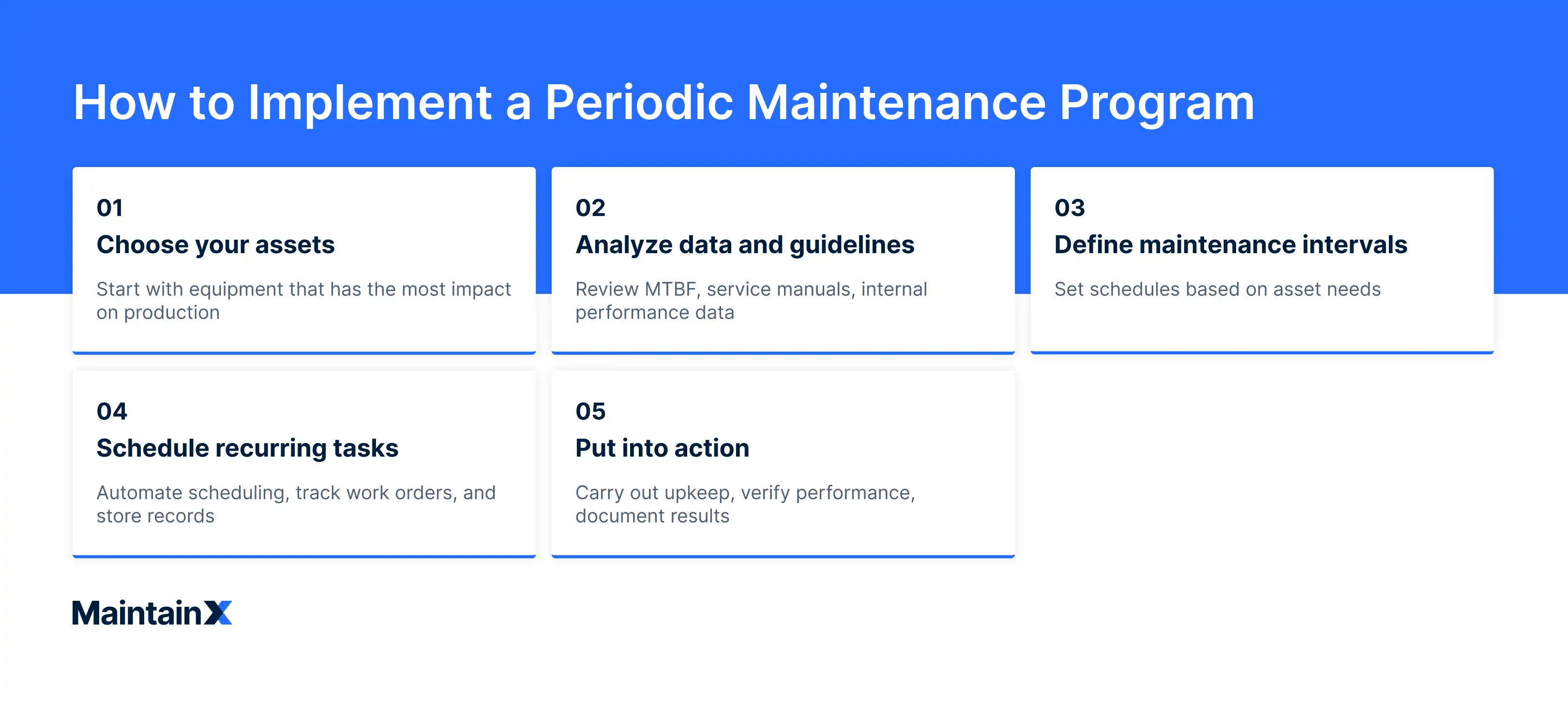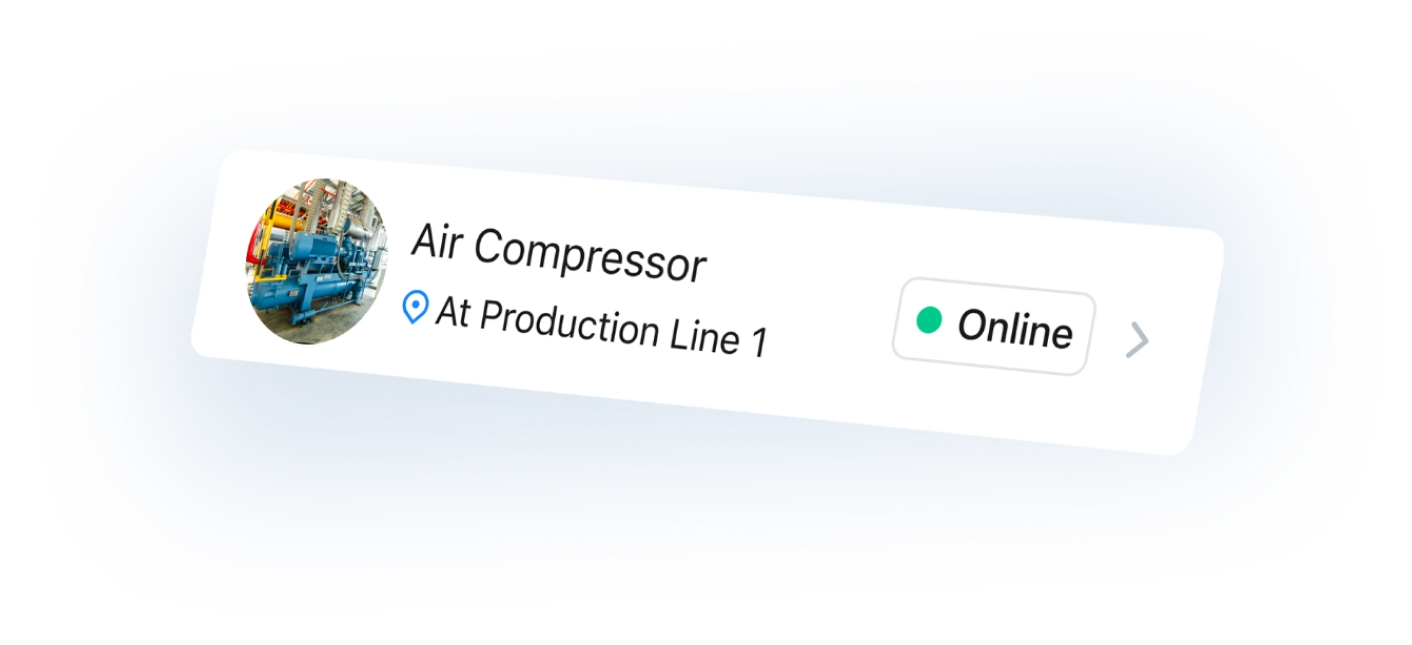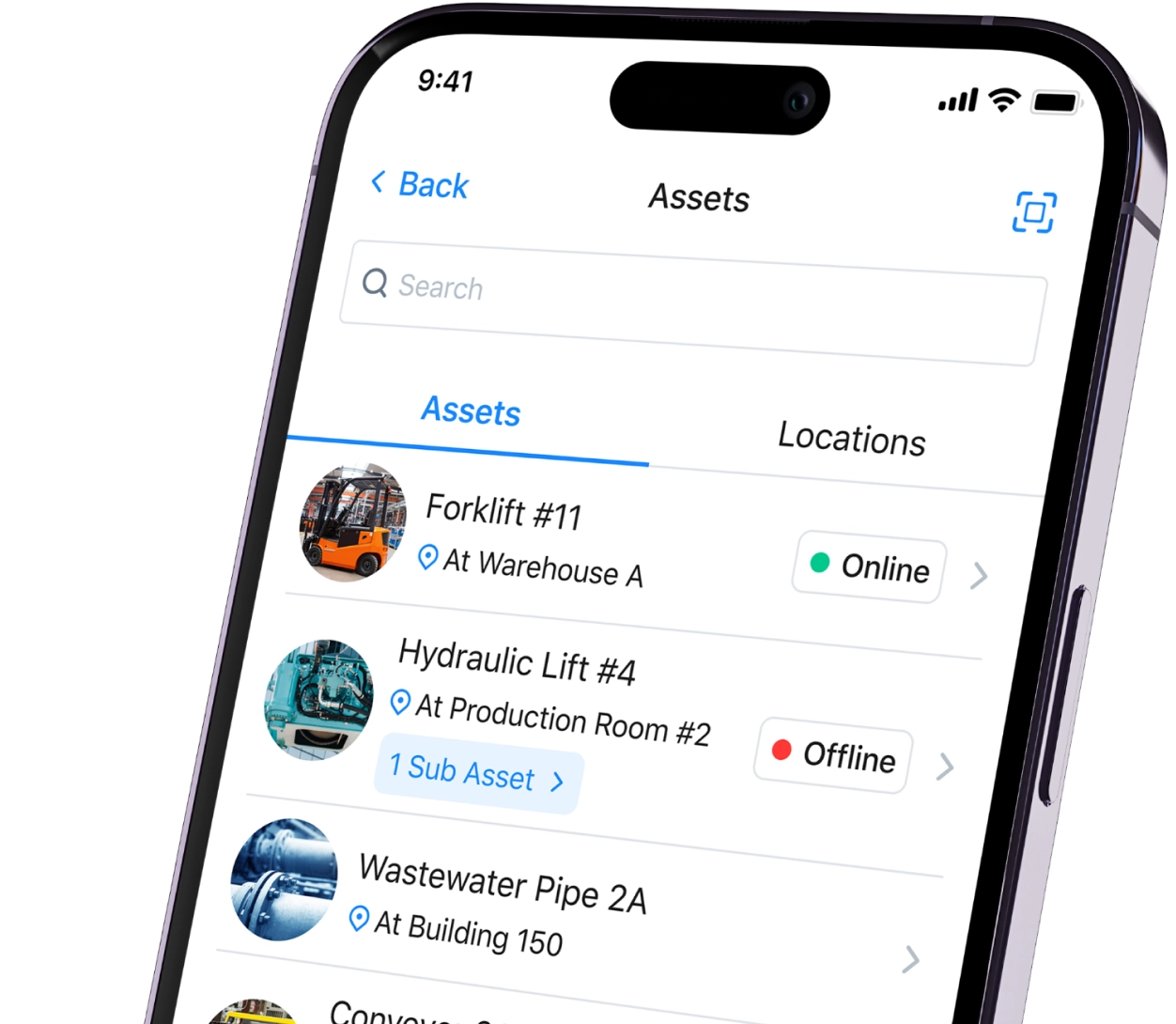Data from our latest State of Industrial Maintenance report reveals a troubling disconnect: while 71% of maintenance leaders have adopted preventive maintenance (PM) as a foundational strategy, less than 35% of facilities actually allocate the majority of their time to preventing breakdowns.
This gap between strategy and execution could be costing your facility significant resources through unexpected equipment failures and costly emergency repairs.
The most effective way to bridge this gap and consistently prevent breakdowns is through structured periodic maintenance programs.
In this guide, you'll learn what periodic maintenance is, how it prevents costly breakdowns, and the step-by-step process for implementing a program that delivers measurable results in your facility.
Key takeaways
- Periodic maintenance transforms maintenance from fixing problems after they occur to preventing them before they happen through consistent, scheduled tasks.
- Periodic maintenance serves three core purposes: extending equipment lifespan through regular care, ensuring reliable performance by catching issues early, and reducing unplanned downtime by transforming emergency repairs into scheduled maintenance.
- Track performance metrics like completion rates and equipment reliability to continuously refine your maintenance schedule based on actual results.
- Balance periodic maintenance with other strategies like condition-based monitoring to create a layered approach that maximizes both maintenance efficiency and equipment protection.
What is periodic maintenance?
Periodic maintenance is a planned maintenance approach in which teams perform specific tasks on equipment at predetermined time intervals (daily, weekly, monthly, annually, etc.).
Unlike reactive maintenance, which waits for equipment to fail, periodic maintenance follows a calendar-based schedule. Your team performs the same maintenance tasks at the same intervals regardless of the equipment's current condition.
Some of the key characteristics of periodic maintenance are that it’s:
- Time-driven: Based on calendar intervals, not equipment condition
- Predictable: You know exactly when maintenance will occur
- Preventive: Designed to prevent failures before they happen
- Standardized: Same tasks performed consistently across intervals
Successful facilities employ a layered approach, where periodic maintenance serves as a reliable foundation, while advanced strategies like predictive maintenance (PdM) and condition-based maintenance provide targeted protection for critical equipment.
How this typically works:
- Periodic maintenance provides scheduled care based on calendar intervals.
- Predictive maintenance utilizes sensors to monitor critical assets and forecast potential failures.
- Condition-based maintenance inspects equipment to assess its current state and triggers tasks only when signs of wear or degradation are detected.
Most facilities blend these strategies based on equipment criticality and available resources rather than choosing just one approach.
Goals of periodic maintenance
Periodic maintenance often forms the foundation of broader preventive maintenance programs.
It focuses specifically on time-based, scheduled tasks and serves three primary objectives:
Extended equipment lifespan
Regular, scheduled maintenance tasks help your assets reach, and often exceed, their expected useful life.
In manufacturing environments, this might mean lubricating conveyor belt motors every 500 operating hours to prevent bearing wear. For HVAC systems, it could involve replacing filters quarterly to maintain airflow efficiency and to prevent system strain.
Enhanced reliability
By addressing wear patterns before they lead to failures, periodic maintenance ensures predictable equipment performance.
For example, a food processing plant might schedule weekly vibration checks on centrifuge pumps and monthly bearing inspections on mixing equipment. These checks catch developing issues during planned maintenance windows rather than peak production hours.
This routine approach is often used in conjunction with more advanced strategies, such as predictive maintenance, which utilizes data from sensors and monitoring tools to forecast when equipment will require service.
Reduced unplanned downtime
By catching problems early, periodic maintenance transforms unpredictable emergency repairs into manageable scheduled maintenance.
Regular inspections help identify developing issues before they cause unexpected equipment failures. You'll experience fewer emergency calls that pull technicians away from planned work, reduced overtime repair costs, and more predictable maintenance schedules.
Periodic maintenance vs. time-based maintenance
Periodic maintenance and time-based maintenance (TBM) are used interchangeably in the maintenance industry. They refer to performing specific maintenance tasks at predetermined time intervals to prevent equipment failures.
A typical example of periodic or time-based maintenance is changing HVAC filters every three months, where the task is performed based on a predetermined schedule rather than the filter's actual condition.
How to implement a periodic maintenance program
Starting a periodic maintenance program doesn't require overhauling your entire operation. Here’s how to approach it:

1. Start with your most critical asset
Choose one piece of equipment to test and refine your approach before expanding the program.
Look for assets that meet one or more of these criteria:
- Production constraints: Equipment that stops your entire line when it fails
- High replacement costs: Machinery that's expensive to repair or replace
- Safety-critical systems: Equipment whose failure could endanger workers
- Customer-facing impact: Assets that directly affect product quality or delivery times
This approach helps you demonstrate ROI before investing time in less critical assets.
2. Gather manufacturer guidelines and historical data
Review your equipment's documentation for recommended maintenance intervals and procedures. Look for the manufacturer's Mean Time Between Failures (MTBF), which is the average time the equipment operates before needing repair.
Also, collect your own data:
- When did this asset last fail and why?
- What repairs have you performed in the past year?
- Are there recurring issues that indicate the need for maintenance?
Your internal data often provides more accurate intervals than generic manufacturer recommendations because it reflects your specific operating conditions.
3. Set your initial maintenance intervals
Use the manufacturer's guidelines as your starting point, then adjust them based on your specific operating environment.
For example, equipment running 24/7 in harsh conditions needs more frequent attention than machines operating a few hours daily in clean environments.
Start conservatively with shorter intervals. You can always extend them as you gather performance data. For detailed guidance on optimizing intervals, see the "Defining ideal intervals for periodic maintenance" section below.
4. Execute, track, and refine your program
When performing scheduled maintenance, your technicians should:
- Follow standardized procedures for each task
- Document any unusual findings or concerns
- Record actual time spent versus estimated time
- Note any parts used or additional work needed
Track key metrics like on-time completion rates, unplanned downtime incidents, and equipment reliability trends.
After three to six months, review your data to optimize the program. Use this analysis to adjust intervals, modify procedures, or add new assets to your program.
Defining ideal intervals for periodic maintenance
Setting the proper maintenance intervals is both critical and complex. If intervals are too frequent, you could spend more than necessary on maintenance, while intervals that are too infrequent might allow preventable failures to occur.
While manufacturer recommendations provide a starting point, your facility's unique operating conditions determine how frequently equipment needs attention. Consider these factors:
- Operating hours: A machine running 16 hours daily needs more frequent maintenance than one running four hours.
- Environmental conditions: Dusty, humid, or high-temperature environments accelerate wear.
- Load factors: Equipment that consistently operates at maximum capacity wears out more quickly.
- Criticality: Assets that halt production when they fail need more conservative intervals.
Intervals should evolve with your equipment, operating conditions, and organizational capabilities. Review and adjust them regularly to keep your periodic maintenance program effective and efficient.
Examples of periodic maintenance
Periodic maintenance helps you address issues before they impact performance or safety. Here are common examples across different industries:
Manufacturing operations
- Lubricating machinery bearings every 1,000 operating hours
- Inspecting and adjusting conveyor belt tension monthly
- Replacing worn cutting tools on CNC machines based on production cycles
Facility management
- Inspecting fire safety equipment quarterly
- Cleaning and calibrating sensors on automated systems
- Testing emergency backup generators monthly
Transportation and logistics
- Checking tire pressure and tread depth on delivery vehicles weekly
- Replacing air filters in warehouse ventilation systems quarterly
- Inspecting and lubricating dock equipment monthly
Food and beverage processing
- Deep cleaning production lines according to sanitation schedules
- Replacing gaskets and seals on processing equipment
- Calibrating temperature monitoring systems monthly for food safety compliance
Each of these tasks follows the same principle: Regular, scheduled intervention prevents minor problems from becoming expensive failures that disrupt your operations.
The pros and cons of periodic maintenance
Understanding both the advantages and limitations of periodic maintenance helps you implement it effectively within your broader maintenance approach.
Pros
- Predictable planning and budgeting: You know exactly when maintenance will occur and can plan accordingly. This predictability helps with resource allocation, parts ordering, and scheduling technicians.
- Simple to implement: The calendar-based approach is easy to understand, and you don’t need sophisticated monitoring equipment or specialized training, just manufacturer guidelines and basic historical data.
- Catches problems early: Regular inspections reveal developing issues during scheduled maintenance windows rather than during critical production times.
- Extends equipment life: Consistent care through routine tasks like lubrication, cleaning, and adjustments helps assets reach or exceed their expected lifespan.
Cons
- Potential over-maintenance: Fixed intervals sometimes result in unnecessary maintenance on equipment that's still performing well, wasting time, parts, and labor.
- Ignores actual equipment condition: Time-based schedules don't account for varying operating conditions or usage patterns. Equipment operating in harsh environments or under heavy loads might experience failures between scheduled maintenance periods.
- Doesn't prevent all failures: Unexpected breakdowns still occur between scheduled maintenance periods. You'll still need to allocate resources for emergency repairs and reactive maintenance situations.
- Limited optimization: Without condition-monitoring data, it's difficult to optimize intervals for maximum efficiency. You might maintain too frequently or not frequently enough without real-time equipment health information.
The key is finding the right balance for your facility's needs and combining periodic maintenance with other strategies where appropriate.
How to determine the ROI of periodic maintenance
Calculating the return on investment for periodic maintenance helps justify program costs and demonstrates the financial value of proactive maintenance, even when benefits aren't immediately visible. Understanding ROI requires recognizing that periodic maintenance involves trading immediate costs for long-term savings.
Here’s how to calculate the ROI of your periodic maintenance program:
Calculate your baseline costs
Start by establishing your baseline costs before you begin periodic maintenance:
- Emergency repair costs: Include parts, labor, and overtime premiums for unplanned repairs.
- Production losses: Calculate lost revenue during unplanned downtime.
- Rush shipping fees: Factor in expedited parts delivery costs for emergencies.
- Secondary impacts: Account for customer penalties, overtime costs for makeup production, and quality issues.
For example, if a critical production line fails and costs you $5,000 per hour in lost production, plus $3,000 in emergency repair costs, a single eight-hour breakdown costs $43,000.
Estimate your program investment
Next, estimate the costs of your periodic maintenance program:
- Labor costs: Technician time for scheduled tasks
- Parts and materials: Consumables like filters, oil, belts, and gaskets
- Training: Initial setup time and ongoing education
Calculate basic program ROI
Use this simple formula to quantify your periodic maintenance program's financial impact:
ROI = (Cost Savings - Program Investment) / Program Investment × 100
Example calculation:
- Annual reactive maintenance costs before program: $150,000
- Annual reactive maintenance costs after program: $75,000
- Annual periodic maintenance program costs: $45,000
In this example, the calculation would be ($75,000 - $45,000) divided by $45,000, multiplied by 100, which equals a 67% return on investment.
Track additional value metrics
Beyond basic ROI calculations, these metrics help you understand your program's broader value:
- MTBF: How much longer equipment runs before requiring repairs
- Planned vs. unplanned maintenance ratio: The percentage of maintenance work that's scheduled versus emergency repairs
- Equipment availability: Percentage of time assets are operational and productive
- Maintenance cost per operating hour: Total maintenance spending divided by equipment runtime
The key is viewing periodic maintenance as an investment rather than an expense. While you'll initially spend more on higher parts inventory and more frequent technician time, these upfront investments pay dividends through reduced emergency repair costs and improved operational reliability.
What is a periodic maintenance schedule?
A periodic maintenance schedule is a calendar-based plan that outlines when to perform specific maintenance tasks on your equipment. It organizes all your time-based maintenance activities into a structured timeline, showing what needs to be done, when, and by whom.
Your schedule should include:
- Task descriptions: What maintenance work needs to be performed
- Frequency: How often each task occurs
- Asset assignments: Which equipment receives each maintenance task
- Resource allocation: Which technicians or teams are responsible
- Parts requirements: What materials or components are needed
A well-organized schedule provides visibility into your team's workload, helping you balance routine maintenance with other operational priorities and ensuring that nothing falls through the cracks.
Using a CMMS for periodic maintenance
A computerized maintenance management system (CMMS) transforms periodic maintenance from a manual scheduling challenge into an automated, efficient process.
Instead of relying on spreadsheets, sticky notes, or memory, a CMMS automatically generates work orders, sends reminders, and tracks completion rates.
Some key CMMS benefits for periodic maintenance include:
- Automated scheduling: Creates recurring work orders based on time intervals or usage metrics
- Centralized tracking: Stores all maintenance history, parts usage, and completion data in one place
- Resource planning: Shows technician workloads and helps balance scheduled tasks
- Performance analytics: Tracks metrics like completion rates and equipment reliability trends
- Mobile accessibility: Allows technicians to access schedules and update work orders from anywhere
Ready to streamline your periodic maintenance program? Learn more about preventive maintenance strategies and how the right tools can enhance their effectiveness.
Periodic maintenance FAQs
The frequency of periodic maintenance depends on several factors, including the type of equipment, operating conditions, and the manufacturer's recommendations. Critical assets in harsh environments may require weekly attention, while equipment in clean, controlled conditions may only need quarterly or annual maintenance tasks.
Start with the manufacturer's guidelines for scheduled maintenance intervals, then adjust them based on your operational experience. HVAC systems typically require filter changes every three months, while industrial machinery may need lubrication every 1,000 operating hours. The key is establishing time-based schedules that prevent equipment failure while avoiding excessive maintenance costs.
Your internal maintenance teams can perform most periodic maintenance activities, particularly routine tasks such as filter changes, lubrication, and basic inspections. In-house maintenance gives you more control over scheduling and cost and builds your team's expertise with your specific equipment.
Consider professional maintenance services for complex equipment or specialized systems that require certifications, or when your maintenance teams lack the necessary capacity. Many facilities employ a hybrid approach, performing routine scheduled maintenance internally while outsourcing specialized maintenance procedures to qualified professionals.
Effective tracking requires a systematic approach to managing maintenance data and scheduled upkeep. A CMMS platform helps you by automatically generating work orders based on time intervals and tracking completion rates for all maintenance activities.
Smaller operations can start with digital calendars with recurring reminders or maintenance management spreadsheets. Make sure you document maintenance tasks performed, the dates on which they occurred, and any issues discovered. This historical data helps maintenance managers make informed decisions about adjusting maintenance intervals and improving maintenance strategies.
Yes, periodic maintenance and time-based maintenance are often used interchangeably in the industry. Both refer to performing maintenance tasks at predetermined time intervals, regardless of the equipment's condition. Whether you refer to it as periodic maintenance, time-based schedules, or scheduled maintenance, the approach remains the same: proactive maintenance based on calendar intervals rather than equipment condition.
Periodic maintenance offers several key advantages over predictive maintenance strategies. Time-based schedules are cost-effective to implement because you don’t need specialized sensors or monitoring equipment. Maintenance teams can easily understand and execute periodic maintenance procedures without extensive training in data analysis.
Predictive maintenance requires a significant investment in monitoring technology and expertise to interpret maintenance data effectively. While predictive strategies can optimize maintenance timing, periodic maintenance provides consistent equipment care and remains the foundation for most maintenance programs. Many successful maintenance strategies combine both approaches, using periodic maintenance for routine tasks and applying predictive maintenance to critical assets.
Companies should prioritize periodic maintenance for equipment where the cost of monitoring is less than the risk of unexpected asset failure. Non-critical assets, standardized equipment with predictable wear patterns, and systems with low replacement costs benefit most from time-based schedules.
Condition-based maintenance is more effective for critical assets, where equipment failure can lead to significant operational disruptions. However, implementing condition-based monitoring requires substantial investment in sensors and data analysis capabilities. Periodic maintenance remains more practical for most maintenance activities, ensuring equipment reliability through regular maintenance without the need for complex monitoring systems.
Industries with equipment that plays a vital role in daily operations benefit most from periodic maintenance programs:
- Manufacturing: Production equipment requires scheduled maintenance to ensure smooth operation and prevent line shutdowns.
- Food processing: Time-based schedules maintain sanitary conditions and ensure compliance with safety regulations.
- Commercial facilities: HVAC systems follow periodic maintenance schedules to maintain indoor air quality and operational efficiency.
- Transportation: Vehicle fleets use scheduled maintenance intervals to prevent breakdowns and ensure safety.
- Healthcare: Medical equipment requires regular maintenance to ensure patient safety and regulatory compliance.
- Energy and utilities: Power generation and distribution equipment needs consistent maintenance to ensure reliable service.
In addition, facilities management across all sectors relies on periodic maintenance to address routine maintenance needs for building systems.
See MaintainX in action








